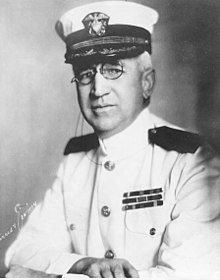
Back إدوين تايلور بولوك Arabic Edwin Taylor Pollock German Edwin Taylor Pollock Spanish Edwin Taylor Pollock French Edwin Taylor Pollock Portuguese Edwin Taylor Pollock Slovenian 埃德温·泰勒·波洛克 Chinese
E. T. Pollock | |
|---|---|
 Capt. Pollock as Superintendent of the U.S. Naval Observatory | |
| Birth name | Edwin Taylor Pollock |
| Born | October 25, 1870 Mount Gilead, Ohio |
| Died | June 4, 1943 (aged 72) Washington, D.C. |
| Allegiance | United States of America |
| Service/ | United States Navy |
| Years of service | 1893–1927 |
| Rank | Captain |
| Commands | USS Virginia USS Kearsarge USS Salem USS Alabama USS Hancock USS George Washington USS Oklahoma Commandant U.S. Naval Station Tutuila Superintendent U.S. Naval Observatory |
| Battles/wars | Battle of Santiago de Cuba |
| Awards | Navy Cross |
| Other work | Military Governor of the U. S. Virgin Islands (acting) and American Samoa |
Edwin Taylor Pollock (October 25, 1870 – June 4, 1943) was a career officer in the United States Navy, serving in the Spanish–American War and in World War I. He was later promoted to the rank of captain.
As a young ensign, Pollock served aboard USS New York during the Spanish–American War. After the war, he rose through the ranks, served on several ships, and did important research into wireless communication. In 1917, less than a week before the United States entered World War I, he won a race against a fellow officer to receive the U.S. Virgin Islands from Denmark, and served as the territory's first acting governor. During the war, he was promoted to captain and a vessel under his command transported 60,000 American soldiers to France, for which he was awarded a Navy Cross. Afterward, he was made the eighth Naval Governor of American Samoa and then the superintendent of the United States Naval Observatory, before retiring in 1927.
As Governor of American Samoa, Pollock is notable for establishing dialogue with the Mau, which eventually led to the dissolution of opposition groups. He firmly denied entry to C.S. Hannum and Samuel S. Ripley, believing their presence would cause even greater trouble than in 1920, and vowed to jail Hannum if he ever returned to American Samoa. Pollock also prohibited the use of Samoan bush medicine and instituted a special tax of $3 per taxpayer. Additionally, he is remembered for giving the final approval for the hanging of Toeupu following his murder conviction.[1] In 1923, Governor Pollock made the first proposal for a museum in American Samoa. This was included in his 1923 report to the Secretary of the Navy.[2] However, work on the museum was not started until the arrival of First Lady Jean P. Haydon in 1969.
- ^ Sunia, Fofō Iosefa Fiti (2001). Puputoa: Host of Heroes - A record of the history makers in the First Century of American Samoa, 1900-2000. Suva, Fiji: Oceania Printers. Page 108. ISBN 9829036022.
- ^ Wright, John C. “The Jean P. Haydon Museum.” Pacific Arts, no. 6 (1992): Page 6. Retrieved on August 1, 2024, from http://www.jstor.org/stable/23409084.
© MMXXIII Rich X Search. We shall prevail. All rights reserved. Rich X Search